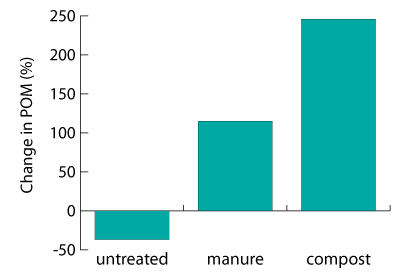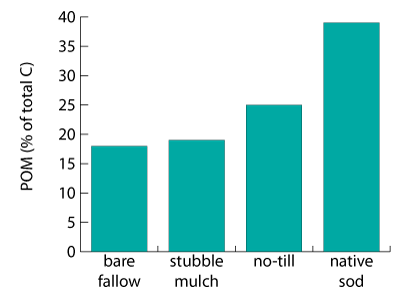Particulate Organic Matter
What it is: Particulate organic matter (POM) fraction referred to in this document comprises all soil organic matter (SOM) particles less than 2 mm and greater than 0.053 mm in size (Cambardella and Elliot, 1992). POM is biologically and chemically active and is part of the labile (easily decomposable) pool of soil organic matter (SOM). Studies have shown that POM accounts for few to large amounts of soil C (20% and more) in some soils of Eastern Canada and the USA depending upon agroecosystems and management practices (see table 1).
| Table 1. Average C in whole soil, POM, percent POM-C (0-10 cm soil depth) from selected study sites in Eastern Canada. Adapted from Carter et al., 2002. | ||||
| Site Name | Management | Whole Soil (C g/Soil kg) |
POM (C g/Soil kg) |
POM (%) |
|---|---|---|---|---|
| St. Rosalie | Continuous corn | 30.2 | 8.2 | 22.5 |
| La Pocatiere | Barley/clover | 23.7 | 2.8 | 11.8 |
| Normandie | Barley/clover | 22.2 | 5.0 | 22.5 |
| Nappan | Continuous grass | 27.1 | 10.1 | 37.2 |
| Benton | Potato rotation | 20.3 | 12.1 | 12.0 |
| Harrow | Corn/oats | 21.5 | 2.7 | 12.5 |
| St. Lambert | Continuous corn | 22.3 | 3.9 | 17.5 |
| Ottawa | Continuous corn | 27.2 | 4.9 | 21.5 |
| Chicott | Continuous corn | 14.5 | 4.3 | 29.3 |
| Harrington | Barley/soybean | 21.2 | 2.8 | 10.8 |
| Delhi | Corn/soybean/ grain/tobacco | 7.6 | 1.4 | 18.4 |
Why it is important: As perhaps the most easily decomposable fraction of nonliving SOM after microbial biomass, POM fulfills many soil functions mediated by OM. It is a source of food/energy for microorganisms and soil animals as well as nutrients for plant growth. Particulate organic matter enhances aggregate stability, water infiltration and soil aeration; it increases cation exchange capacity and buffering pH. It also binds environmental pollutants such as heavy metals and pesticides. Particulate organic matter may play an important role in the suppression of soil borne diseases (e.g. damping off of cucumber) by compost. This may be explained by the fact that POM is an important source of food/energy in the compost for microorganisms responsible of disease suppression.
Specific problems that might be caused by poor function: In poorly managed soils, the transport by erosion of sediments rich in POM into rivers and other water bodies can result in alteration of water quality and aquatic life. Build up and mineralization of those organic materials lead to the eutrophication of lakes and rivers. Incomplete mineralization of POM C in very poorly drained soils can lead to the formation of methane, which escapes into the atmosphere and contributes to ozone depletion.
What you can do: Management that affects SOM accumulation also affects POM content in soil (see figures 1 and 2). More POM in the soil means that carbon and other nutrients are being stored in the intermediately available pool and are not subjected to losses (e.g., leaching) yet are available when needed. The following practices enhance POM levels:
- Tillage management (no-till, strip till, and ridge till)
- Crop rotation, cover crops, and cropping frequency (reduction in fallow frequency)
- Application of manure/compost and organic byproducts
- Pasture and hay land management (e.g., rotational grazing and haying)

Figure 1. Effect of soil amendments on POM in crop soils. Adapted from Fronning et al., 2008.

Figure 2. Effect of soil amendments on POM. Adapted from Cambardella and Elliot, 1992.
For more information go to Soil Management Practices.
Measuring particulate organic matter:
There are several different laboratory methods to estimate POM and associated carbon. No reliable field methods exist yet. POM measurement in laboratory is timeconsuming (1 to several days).
Cambardella CA and Elliot ET. 1992. Particulate soil organic matter changes across a grassland cultivation sequence. Soil Sci Soc Am J 56:777-83.
Carter MR, Angers DA, Gregorich EG, and Bolinder MA. 2003. Characterizing organic matter retention for surface soils in eastern Canada using density and particle size fractions. Can J Soil Sci 83:11–23.
Fronning BE, Thelen KD, and Min D. 2008. Use of manure, compost, and cover crops to supplant crop residue carbon in corn stover removed cropping systems. Agron J 100:1703-10.
